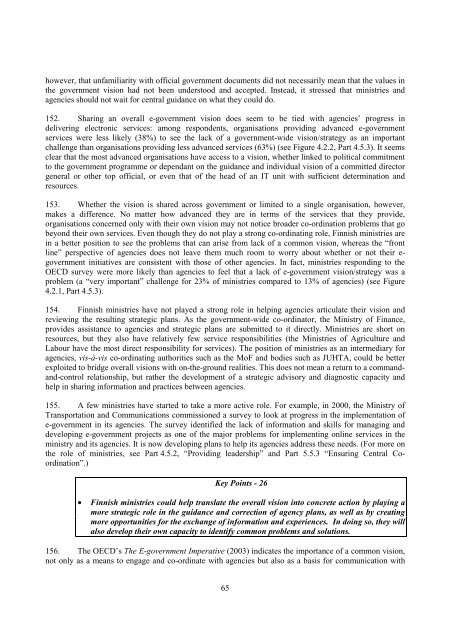e-GOVERNMENT IN FINLAND - ePractice.eu
e-GOVERNMENT IN FINLAND - ePractice.eu
e-GOVERNMENT IN FINLAND - ePractice.eu
You also want an ePaper? Increase the reach of your titles
YUMPU automatically turns print PDFs into web optimized ePapers that Google loves.
however, that unfamiliarity with official government documents did not necessarily mean that the values in<br />
the government vision had not been understood and accepted. Instead, it stressed that ministries and<br />
agencies should not wait for central guidance on what they could do.<br />
152. Sharing an overall e-government vision does seem to be tied with agencies’ progress in<br />
delivering electronic services: among respondents, organisations providing advanced e-government<br />
services were less likely (38%) to see the lack of a government-wide vision/strategy as an important<br />
challenge than organisations providing less advanced services (63%) (see Figure 4.2.2, Part 4.5.3). It seems<br />
clear that the most advanced organisations have access to a vision, whether linked to political commitment<br />
to the government programme or dependant on the guidance and individual vision of a committed director<br />
general or other top official, or even that of the head of an IT unit with sufficient determination and<br />
resources.<br />
153. Whether the vision is shared across government or limited to a single organisation, however,<br />
makes a difference. No matter how advanced they are in terms of the services that they provide,<br />
organisations concerned only with their own vision may not notice broader co-ordination problems that go<br />
beyond their own services. Even though they do not play a strong co-ordinating role, Finnish ministries are<br />
in a better position to see the problems that can arise from lack of a common vision, whereas the “front<br />
line” perspective of agencies does not leave them much room to worry about whether or not their egovernment<br />
initiatives are consistent with those of other agencies. In fact, ministries responding to the<br />
OECD survey were more likely than agencies to feel that a lack of e-government vision/strategy was a<br />
problem (a “very important” challenge for 23% of ministries compared to 13% of agencies) (see Figure<br />
4.2.1, Part 4.5.3).<br />
154. Finnish ministries have not played a strong role in helping agencies articulate their vision and<br />
reviewing the resulting strategic plans. As the government-wide co-ordinator, the Ministry of Finance,<br />
provides assistance to agencies and strategic plans are submitted to it directly. Ministries are short on<br />
resources, but they also have relatively few service responsibilities (the Ministries of Agriculture and<br />
Labour have the most direct responsibility for services). The position of ministries as an intermediary for<br />
agencies, vis-à-vis co-ordinating authorities such as the MoF and bodies such as JUHTA, could be better<br />
exploited to bridge overall visions with on-the-ground realities. This does not mean a return to a commandand-control<br />
relationship, but rather the development of a strategic advisory and diagnostic capacity and<br />
help in sharing information and practices between agencies.<br />
155. A few ministries have started to take a more active role. For example, in 2000, the Ministry of<br />
Transportation and Communications commissioned a survey to look at progress in the implementation of<br />
e-government in its agencies. The survey identified the lack of information and skills for managing and<br />
developing e-government projects as one of the major problems for implementing online services in the<br />
ministry and its agencies. It is now developing plans to help its agencies address these needs. (For more on<br />
the role of ministries, see Part 4.5.2, “Providing leadership” and Part 5.5.3 “Ensuring Central Coordination”.)<br />
Key Points - 26<br />
x Finnish ministries could help translate the overall vision into concrete action by playing a<br />
more strategic role in the guidance and correction of agency plans, as well as by creating<br />
more opportunities for the exchange of information and experiences. In doing so, they will<br />
also develop their own capacity to identify common problems and solutions.<br />
156. The OECD’s The E-government Imperative (2003) indicates the importance of a common vision,<br />
not only as a means to engage and co-ordinate with agencies but also as a basis for communication with<br />
65
















